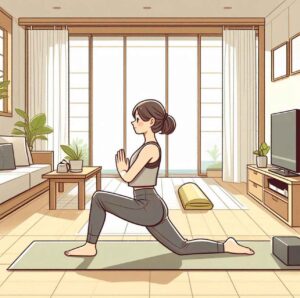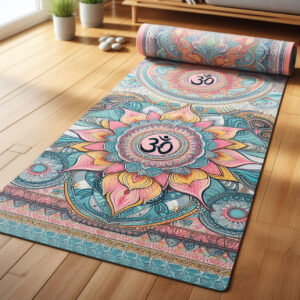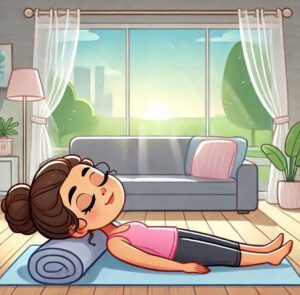Welcome Blessings!
(Tap 🔽 to see more topics!)


Yoga at home, a moment of calm, a quiet space carved out just for you, right in your living room. The idea of yoga can feel like trying to decipher a secret code at first. You see images of people twisted into impossible shapes, hear terms that sound from another language, and wonder where to begin. But yoga isn’t about being a pretzel or needing fancy gear. It’s about finding a little more strength, a little more flexibility, and a whole lot more peace, both in your body and your mind. Think of it as a way to hit the reset button, shake off the day’s stress, and feel good.
Yes, you can do this at home without breaking the bank or dedicating hours of your precious time. Whether you’re looking to get a bit fitter, manage everyday aches and pains, or find a moment of quiet in the chaos, yoga can be your friend. In today’s article, you will learn some practical tips and tricks to help you start your yoga journey right now in your own space.
The first thing people usually wonder is, “Which yoga style is my style?” It’s like picking a flavor of ice cream – there’s something for everyone, and you might even like a few different kinds! Yoga has been around for ages, and people have developed different ways to practice it. You’ve probably heard names like Hatha, Vinyasa, or even Bikram. Don’t let those names scare you! They’re just different approaches.

The best way to figure out what you like is to try a few different styles. You can find tons of free videos online or even try a beginner class at a studio to see what it’s like in person. Don’t be afraid to experiment! You might be surprised by what you enjoy. It’s normal to try a style and think, “Nope, not for me,” and then find one you love. Just keep exploring and have fun with it.
So you’re ready to try yoga at home. That’s fantastic! Now, let’s talk about getting set up without making it a big production. You don’t need a fancy studio or a ton of expensive gadgets. You probably have most of what you need already.
1. Yoga Space
2. The Mat Situation

3. Props (or Improvised Props)


4. Guidance is Key
The point is, don’t let a lack of equipment hold you back. You can start your yoga journey with some space and straightforward guidance.
You don’t need a fancy studio or a room dedicated solely to yoga. Think of it more like carving out a little corner of your world where you can breathe and move. It’s about creating a good space where you can let go of the day’s chaos. To make that happen, read the following tips:
1. Clean and Comfortable Zone. Find a spot where you can spread out a bit. You want to be able to stretch your arms and legs without bumping into anything. Clear the clutter and make sure the floor is relatively clean. A rug or a yoga mat is perfect, but even a towel will do. Think safe. There are no tripping hazards, no sharp edges, just a simple, open area.
2. A Little Peace. We all know how distracting noise can be. Try to pick a time when things are calmer in your house, like early morning or after the kids are in bed. Consider some soft, calming music if complete silence isn’t an option. You can even use candles or essential oils if that helps you relax. It’s all about creating an atmosphere that enables you to unwind.

3. Finding Your Time. There’s no magic time for yoga. It’s really about what works for you. Some people love a morning practice to energize them for the day, while others prefer an evening session to release tension.
It’s all about making it work for your life. You’re not aiming for perfection; you need peace and movement in your day.
The key is to find a routine that works for you. You don’t need a drill sergeant yelling orders; just a few friendly guidelines to keep you on track. Think of it like a recipe, a basic outline you can tweak to your taste.
1. Start with a little warm-up. Think of it like stretching before a walk. You wouldn’t just jump into a run, would you? Gentle stretches, a few deep breaths, or even a couple of rounds of those “sun salutations” you might’ve heard of are perfect. They get your muscles ready and help you avoid that “oops, I pulled something” moment.
2. Breathe, breathe, breathe. Seriously, don’t hold your breath! It’s easy to forget when trying a new pose, but your breath is your best friend. Inhale, exhale, nice and steady. It helps you stay focused, calms your nerves, and makes the whole experience more enjoyable.
3. Pay attention to your body in each pose. This isn’t about looking perfect. It’s about feeling good. If something hurts, stop! You’re not trying to win a flexibility contest. Focus on good form; if a pose is too challenging, there’s always a simpler version. Listen to your body, and don’t push past discomfort. Good form helps you to:
4. Go with the flow. Yoga should feel smooth, not jerky. Try to move from one pose to the next with a sense of rhythm. It’s okay if you’re not perfectly graceful initially; that comes with practice. Feel free to change things up depending on how you’re feeling that day. Some days, you might want a slow, relaxing flow; other days, you might want something more energetic.
5. Don’t forget to chill out at the end. This is the best part! Take a few minutes to lie down, close your eyes, and breathe. Let your body and mind soak in all the good vibes. Grab a blanket or a pillow to make it extra cozy. It is where you get to reap the benefits of your practice. It helps you to:
The main thing is to be kind to yourself. Yoga is a journey, not a race. You’ll have good and not-so-good days, and that’s perfectly normal. Just keep showing up, and you’ll be amazed at how much you progress.
You’ve cleared some space, found a comfy spot, and are ready to do yoga. Awesome! Here is the most crucial part that makes it all worthwhile… enjoy it! Seriously, that’s it! Forget the perfect poses you see online. Just focus on how good it feels to move and breathe. Look, nobody starts as a yoga master. It’s a journey, not a race. So, forget the expectations and judgments. Instead, try to bring these straightforward attitudes to your practice:

Alright, so we’ve covered the basics, and hopefully, you’re feeling a little less “intimidated yoga newbie” and a little more “I could do this.” The truth is that yoga is so helpful for your body and mind. It’s not about being the best, the bendiest, or the most “zen.” It’s about finding a little bit of calm in the chaos, a little bit of strength where you thought you had none and a lot of feeling good.
Take a deep breath, roll out that imaginary (or real!) mat, and try it. You might surprise yourself. Remember, it’s your journey, and every little bit counts. Who knows you might discover a whole new side of yourself. Ready to try yoga? Why not start with just five minutes today? Find a quiet spot, close your eyes, and take a few deep breaths. That’s it. You’ve just started your yoga journey. Let us know how it goes in the comments! Voila! Until next time!